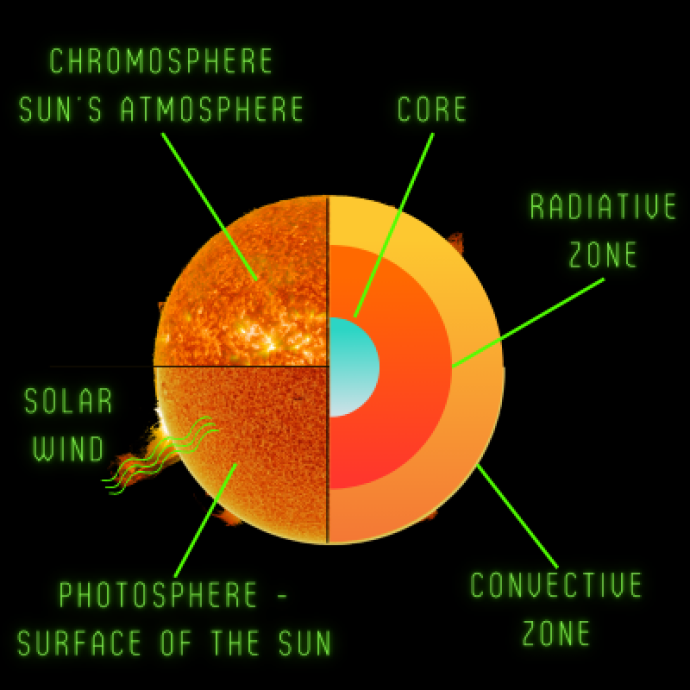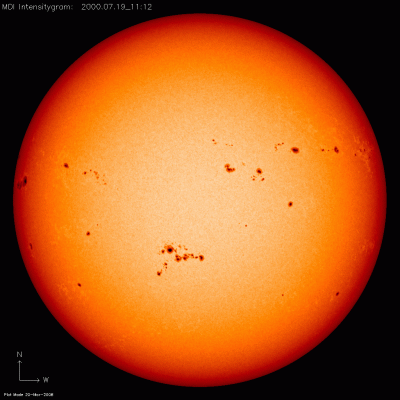The Sun is a star in the centre of our Solar System. It is the largest object and the only star in our Solar System. It is one of billions of stars in our galaxy, the Milky Way.
It looks bigger than the other stars we see in the night sky because it is far closer to Earth. It is only 150 million kilometres away! Alpha Proxima is the next nearest star, 40,000 billion km from Earth!
Without the energy and heat from the Sun, life would not exist on Earth, and we wouldn't have daytime or seasons.

The Sun is the only object in our Solar System that makes its own light. Everything else, like the Earth and our Moon, can be seen when it reflects light from the Sun.
Remember, the Sun's light is powerful. Never look directly at the Sun, not even when wearing dark glasses. The light could damage your eyes.
You may have noticed that the Sun appears to move across the sky each day, rising in the east and setting in the west. The Sun actually stays where it is in the centre of the Solar System. The Earth's rotation on its axis makes it look like the Sun is moving!
- How big is the Sun?
It is 1.4 million kilometres wide, more than 100 times wider than Earth. It contains more than 99.8% of all the mass in the Solar System, with the gas giant planet Jupiter containing most of the rest.
Because it is so massive, the Sun's gravity is very strong—strong enough to influence objects across huge distances. The Sun's gravity keeps every object in our Solar System (planets, asteroids, dwarf planets) in orbit around the Sun.
The Sun is a hot spherical ball of glowing gas we call plasma. The Sun is 75% hydrogen, and most of the rest (24%) is helium. These are the lightest chemical elements. They are also the most common elements in the Universe. The Sun also has small amounts of oxygen, carbon, neon and iron. Nuclear reactions deep inside the Sun made these heavier elements.
There are three main parts to the Sun. The core at its centre is the hottest part. Deep in the Sun's core, temperatures reach 15 million degrees Celsius! Around the core is the radiative zone. Energy is carried through this area, away from the core, as thermal radiation. Around that is the convective zone. Heat moves around this zone like soup bubbling in a pot.
The visible layer of the Sun is called the photosphere. The photosphere's temperature is about 6,000 degrees Celsius, giving it its yellow colour. The Sun also has an atmosphere. Some of the Sun's atmosphere escapes into space - we call this the solar wind. It takes 50 million years for the Sun's energy to travel from the core to the surface. And then another 8 minutes for the light to reach us here on Earth!
Image CreditThis work by The Schools' Observatory is licensed under All rights reserved
CreditThis work by The Schools' Observatory is licensed under All rights reservedThe different layers of the Sun. - How old is the Sun?
Scientists have worked out that the Sun is about 4,500 million years old. It was made from part of a giant cloud of gas and dust. The pull from the cloud's gravity caused it to clump together and collapse inwards.
As the gas and dust fell to the centre of the cloud, the temperature and pressure increased. When the temperature got as high as 1 million degrees Celsius, the Sun began to shine.
The Sun, like all stars, shines and releases energy through a process called nuclear fusion. The hot, high pressure in the cores of stars creates the right conditions for nuclear fusion to take place.
- Does the Sun change?
You might think that the Sun stays the same and does not change. Yet, research shows us that the Sun is an active star that changes with time. Like the Earth, the Sun has a magnetic field. This magnetic field varies with time because the Sun rotates. The Sun's equator spins at a faster rate than its poles do, making the magnetic field lines curve and twist. This twisting causes changes in the Sun's activity.
For 100s of years, scientists have measured this solar activity. The data lets them predict when the Sun's activity will peak. We call these peaks solar maximums. A solar maximum takes place about every 11 years. There are many ways of measuring solar activity. One way is to count the number of sunspots and solar flares on the Sun over time.
- Sunspots and Solar Flares
The surface of the Sun that we see is called the photosphere, and it is not all the same. There are bright areas, which are hotter than the rest of the surface, and dark areas, which are colder.
Dark patches on the surface of the Sun are called sunspots. Whilst the photosphere has a temperature of around 6000 °C, sunspots are between 3000 °C and 4000 °C.
Sunspots do not stay in the same place; they move across the surface of the Sun. They also change in size, expanding and shrinking. Large sunspots can grow up to 50,000 km in diameter.
They appear in pairs, with one a magnetic north pole and the other a magnetic south pole. Magnetic field lines come out of the surface of the Sun through one sunspot and go back in through the other. The strong magnetic field around the sunspots stops heat from being moved by convection. Convection moves heat from deeper inside the Sun to the surface. The lack of convection makes them cooler than the rest of the surface.
Image CreditThis work by NASA/SOHO is licensed under Creative Commons Zero v1.0 Universal
CreditThis work by NASA/SOHO is licensed under Creative Commons Zero v1.0 UniversalSunspots at solar maximum Sunspots have been seen and studied since 1610. Galileo made a series of observations and tracked their movement. He used the movement of sunspots to figure out that the Sun rotates. At the time he calculated that the Sun rotated once each month. Today scientists have found that sunspots actually rotate around the Sun at different rates. Sunspots close to the equator of the Sun rotate once every 25 days, whereas sunspots near the poles rotate every 38 days.
The Sun is not perfectly round: it is an 'oblate spheroid'. This means the Sun is wider around its equator than at its poles, like a squashed ball. Above the sunspots, the magnetic field of the Sun is tightly twisted. This twisting builds up energy until it can take no more. Then, it unwinds suddenly. The energy released heats the material on the surface of the Sun to millions of degrees. This causes particles to erupt from the surface. The light related to it can cover all wavelengths. This is known as a solar flare, lasting minutes to hours. They travel at the speed of light, which means we only see them at the same time they reach the Earth.
During a solar flare, particles such as photons, electrons, and protons are released from the Sun. The Sun's atmosphere heats these particles, giving them a lot of energy. The energy released in a solar flare is 10 million times more than in a volcanic eruption!
The particles in a solar flare are sent out into the Solar System. They can be dangerous if they come towards the Earth. The charged particles in the flares can damage satellites. The high-energy photons (radiation) can pose a danger to astronauts in the International Space Station. This means that it is important that we watch the Sun and try to predict when solar flares could happen. If we can predict this 'space weather,' we can try to prepare for it.
Image CreditThis work by I, Eyrian is licensed under GNU General Public License v2.0 or later
CreditThis work by I, Eyrian is licensed under GNU General Public License v2.0 or laterConvective transport - What will happen to the Sun?
The Sun will carry on shining for another 5,000 million years. This period of time is called its main sequence. It will then begin to run out of nuclear fuel, which powers its core, and expand to become a red giant star.
Some stars explode once they run out of fuel. The Sun is not big enough to explode. Instead, it will lose its outer layers over a long time - we call this a planetary nebula. The central mass of the Sun will shrink to a dense white dwarf. Finally, it will dim, stop shining, and become a black dwarf.
